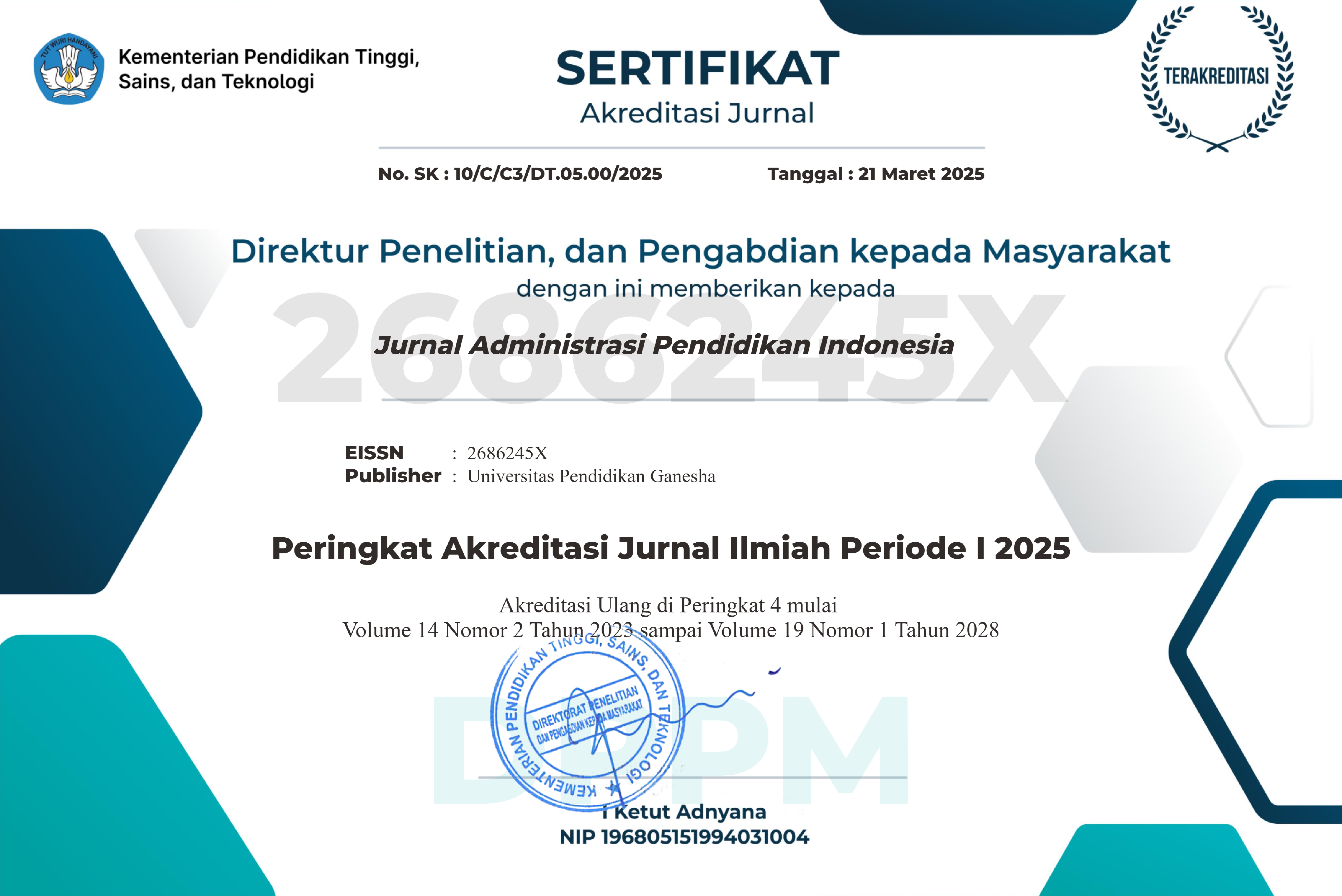Evaluation of the Implementation of the e-raport at State High Schools in Singaraja City
DOI:
https://doi.org/10.23887/jurnal_ap.v13i1.966Keywords:
E-report system, Evaluation Study, CIPPAbstract
This study aims to investigate both partially and simultaneously the components of context, input, process, product and the obstacles that occurred in the implementation of the E-report system at public high schools in the city of Singaraja. The CIPP model is used in this research. The population of this study was 200 teachers from three public high schools in Singaraja namely teachers of SMAN 1 Singaraja, SMAN 2 Singaraja, and SMAN 3 Singaraja with a total sample of 172 teachers. The data for each variable were collected by using the Five-point Likert scale questionnaire model with descriptive quantitative data analysis method. In order to determine the effectiveness of the E-report system implementation, the raw score is transformed into Z-score and into T-score continued to the verification of the score into the Glickman quadrant. The data analysis results show: 1) The effectiveness of the E-report system implementation from the context component is identified as effective (+), 2) The effectiveness of the E-report system implementation from the input component is identified as effective (+), 3) The effectiveness of the E-report system implementation from the process component is identified as effective (+), 4) The effectiveness of the E-report system implementation from the product component is identified as effective (+), The evaluation result on the effectiveness of the E-report system implementation from the context, input, process, product components simultaneously is identified as highly effective (+ + + +). Alternative solutions for the obstacles encountered in the implementation of the E-report system have been explored namely the solutions regarding the issue with the program coordinator contract status, organizational structure, teachers’ incompetence, students’ responses, low budget, and the socialization of the E-report program guidelines.
Key words: E-report system; Evaluation Study; CIPP
References
Anugerah, Y., Ambabunga, M., & Sampetoding, E. A. M. (2021). Pemanfaatan Sistem Aplikasi E-Rapor Untuk Memudahkan Proses Penginputan Nilai Siswa SMA Negeri 1 Rantepao Kabupaten Toraja Utara Provinsi Sulawesi Di Masa Pandemi Covid-19. Indonesian Journal of Community and Service (IJOCS), 1(2), 2775–2666.
Budi Yoga Bhakti. (2017). Evaluasi Program Model CIPP Pada Proses. Jurnal Inovasi Pendidikan Fisika Dan Riset Ilmiah, 1(2), 75–82.
Firmanda, K. B., & Ma’ruf, M. F. (2017). Implementasi Program Rapor Online Di SMK Negeri 1 Surabaya. Jurnal Ilmu Sosial Dan Hukum, 5(4), 1–8. www.academia.edu/pemanfaatan-e-governmentdalam-
Hafid, R. N. H. (2021). The difference of satisfaction level of midwifery students in trying out competency test with computer-based test and web-based test. Internasional Journal Health & Medical Sciences, 4(1), 8–14.
Hamdani. (2011). Strategi Belajar Mengajar. CV.Pustaka Setia.
Hikmah, R. L., Ramdani, A., & Asrin, A. (2021). Manajemen Program E-Rapor di SMA Negeri 7 Mataram. Jurnal Ilmiah Mandala Education, 7(3), 567–571. https://doi.org/10.36312/jime.v7i3.2315
Indrajit, R. E. (2000). Manajemen Sistem Informasi dan Teknologi Informasi. PT. Alex Media Komputindo.
Jannah, M. (2019). Manajemen Program Penilaian Hasil Belajar Berbasis E-Rapor di SMA Negeri 3 Sidoarjo. Inspirasi Manajemen Pendidikan, 3.
Nugraha, F. M. (2018). ANALISIS PERBANDINGAN SISTEM DATA POKOK PENDIDIKAN ( DAPODIK ). 1(April), 87–95.
Nugraha, I. N. P., Dantes, K. R., & Widhiyanti, D. A. (2015). Studi Evaluasi Efektivitas Pelayanan AdministrasiAkademik diLingkungan Fakultas Teknik Kejuruan Undiksha. 525–530.
Oktavia, N. (2015). Sistematika Penulisan Karya Ilmiah. Deepublish.
Permendikbud tentang Standar Penilaian Pendidikan, Pub. L. No. 23 (2016).
Pratama, Y. H., Rosidi, A., Sleman, K., & Yogyakarta, D. I. (2020). PENDEKATAN VALUE CHAIN ( Studi Kasus : SMKN 5 Mataram ). 106–118.
Republik Indonesia, P. & K. (2021). P. P. R. I. N. 57 T. 2021 tentang S. N. P. (2021). Peraturan Pemerintah Republik Indonesia Nomor 57 Tentang Standar Nasional Pendidikan. Standar Nasional Pendidikan, 102501, 1–49.
Roekminiati, S., & Dwiyanti, P. (2017). 260-Article Text-645-1-10-20170719.pdf. Jurnal Ilmiah Fenomena, 3(6), 274–347.
Sudjana. (2011). Dasar-dasar Proses Belajar Mengajar. Sinar Baru Algensindo.
Sugiyono. (2017). Metode Penelitian Kuantitatif, Kualitatif, dan R&D. ALFABETA.
Sugiyono. (2018). Metode Penelitian Kuantitatif, Kualitatif, dan Kombinasi (Miz Methods) (10th ed.). ALFABETA.
Sunu, I. G. K. A. (2010). Pengelolaan Pendidikan Multikultural (Studi Kasus pada SMP/MTs di Provinsi Bali.
Wirasasmiata, R., & Uska, M. (2019). Evaluation of E-Rapor Usability using Usability Testing Method. 330(Iceri 2018), 71–74. https://doi.org/10.2991/iceri-18.2019.15











